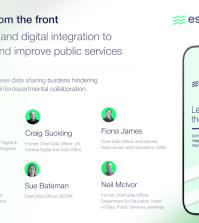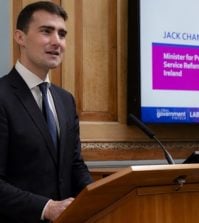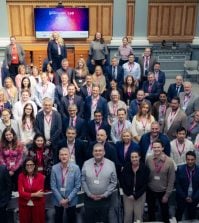From mini-state to digital giant: Siim Sikkut on Estonia’s remarkable journey

How did a tiny Baltic state become the world’s foremost digital government? Matt Ross asks Siim Sikkut, who’s just completed a five-year term as Estonia’s government CIO, to explain
Google ‘world’s most advanced digital government’, and the first two pages of results name only one country: Estonia. The UN’s E-Government Survey, Wired magazine, and Blavatnik School of Government’s International Civil Service Effectiveness Index all rate the tiny Baltic state’s digital services as the world’s best; the EU’s EGovernment Benchmark hands it the silver medal.
Through interviews and features with key Estonian leaders (see footnote), Global Government Forum has documented the country’s remarkable digital systems and services. We know what has been achieved; but why here? Just how did this tiny, largely rural nation on the north-eastern fringes of Europe emerge as a digital superpower?
There is, of course, no single or simple answer. But few are better placed to trace the roots of Estonia’s success than Siim Sikkut, who’s just stepped down after five years as government CIO. And those roots, he explains, reach down into the country’s unhappy years as part of the USSR, when every republic was “assigned some speciality. Latvia was doing refrigerators and bicycles. Estonia happened to be doing computer science”.
So when Estonia secured its independence in 1989, it already had a talent pool. And the new government put IT at the centre of its development strategies, launching the ‘Tiger Leap’ programme in the mid-‘90s “to take the internet into all schools and everywhere in the country,” Sikkut recalls. During his own schooldays, he remembers, “we got hooked in terms of what this great worldwide web was about”.
As part of the “Tiger Leap generation”, Sikkut gained an “appreciation and fascination for technology”. And though he spent his early career in economic development and strategic planning roles at the Ministry of Finance, “I quite quickly realised that if Estonia has one shot in the world, that’s in digital”. A decade ago, he joined the Government Office of Estonia “working for prime ministers on digital policy, in a coordination role across government”.
A fresh start
Alongside its legacy of IT development, the country had some further advantages in the field. Building an IT infrastructure from scratch after escaping the Soviet Union, it evaded the legacy issues that bedevil so many governments. And its tiny size – the country has just 1.3 million residents – permits a certain nimbleness in its civil service: as Sikkut comments, “there are less people to convince to get something done!”.
Estonia’s focus on digital was also, he explains, a response to its limited resources: only by shifting its operations online could the government afford to provide its rural population with high-quality services. Pondering countries that have become “stuck on digital”, Sikkut asks: “Is there a burning platform?” In large, rich countries, he suggests, “you can talk about national debt and stuff like that, but they don’t feel the pain”.
He does not say so, but the country’s difficult relationship with Russia may also have hastened its IT development. Long the subject of cyber attacks by actors operating out of its vast neighbour, Estonia has taken radical action to secure its digital infrastructure – building ‘digital embassies’ abroad to hold data backups and operate critical services.
Read more: Finding your identity: solving the digital ID verification challenge
On leaders and license
At the heart of Estonia’s achievements, though, lie very human factors: digital leaders have enjoyed the space and freedom to experiment and take risks; to develop and implement ambitious ideas; to invest in new capabilities without a clear end goal. As Heiki Loot told GGF in 2018 when in the late ‘90s the then-PM launched Estonia’s ID card system, “nobody knew what you could do with ID cards”.
He added: “There were no digital services, and many said that it was a waste of money”. But this crucial investment “created the infrastructure for the development of e-services”.
Asked the source of this license to innovate, Sikkut is reluctant to allocate it to cultural factors. “We’re a farming country,” he notes, “very traditional in our roots”. And to some extent, Estonia’s iterative, experimental approach was simply “rational practice” in an environment where money was tight. “If you have little resources, you don’t commit all the way through; you start running with what you have,” he comments. “As the Chinese say, we cross the river feeling for the stones.” The world has since caught up, understanding that the ‘Agile’ approach to project management best supports digital schemes, “and these days we do it more consciously. But previously, it was just the natural way to go”.
It is, though, clear that Estonians’ expectations and principles provide a supportive framework. The country, says Sikkut, has a “community that understands that if you try something in earnest and fail – as opposed to failing because of ignorance or misdeeds or whatever – then that’s okay. I’ve never felt in my job that if I failed, something bad would happen”.
These attitudes are set at the top: Estonia has benefited from a series of political and civil service leaders with “open mindsets and a taste for experimentation”, during whose tenures digital specialists could press forward. Sikkut has, he recalls, served “seven ministers and three prime ministers; none of them have been afraid to fail”. Indeed, the PM who appointed him CIO told him: “Don’t be afraid to make mistakes, as long as you’ve tried to avoid them”. And it’s helpful that Estonia’s political opposition and media tend to take a constructive line: “The bloodier that game, the more the disincentive against changing things,” he comments.
Not every leader has supported innovation and transformation, however. Experimentation is “not somehow in our DNA,” says Sikkut. “I think rather that we managed to make the most of the windows of opportunity that have emerged.”
Responsive government
Estonia’s e-Residency programme – which allows foreign nationals to create authenticated digital IDs and register businesses – “was the most conscious effort to put into action the experimentalist approach,” he notes. “We actually called it a government start-up.” And like a start-up, it’s adapted rapidly to new circumstances. In 2019, the target audience was highly-mobile professionals without a tax base; when the pandemic curtailed their movements, the programme pivoted to promote its efficient, straightforward business registration services. Many Europeans base their companies in Estonia “just because it’s so hard and cumbersome to run a company digitally in their home countries,” says Sikkut. “We just offer them an easier way to get things done.”
Read more: Digital citizens: an interview with Estonia’s e-Residency chief, Ott Vatter

Closely linked to Estonia’s “experimentalist” approach is its dependence on “open innovation: we invite others to come build with us and for us”. The country’s leaders, says Sikkut, know that “we in government are not necessarily the brightest ones in the room, so we’d better make it easy for others to chip in, contribute ideas”.
The greatest single legacy of this attitude is the X-Road data exchange platform, which “was a Masters thesis back in the day, then became a whole-government solution. Now it’s in 20 countries around the world”. And its latest manifestation is the Digital Testbed Framework, under which companies, universities and others are invited to build tools and services within the government’s digital infrastructure. Civil servants will benefit from a stronger digital marketplace, while their partners win access to a demonstration platform and perhaps a little reflected glory. Like e-Residency, the Framework represents a conscious effort to provide infrastructure and markets for Estonia’s business services and technology businesses – one of government’s digital goals for decades.
Coordination, not control
To marshal government’s digital staff behind those goals, Sikkut operates with a central staff of just 30; so delivery is necessarily left to the departments. His team provides “direction, and coordination mechanisms so that everybody’s on the same page,” he says, but “every agency is a digital agency in their domain. They’re the service owners, and run the show in their field. We try to nudge everybody forward.”
No country has a perfect governance model, he adds; there’s nothing magical about Estonia’s organisational set-up. It doesn’t matter where the central team is situated, for example: “What matters most is the leverage mechanisms you have, and how much resources you have to charm [agencies] or build stuff yourself.” Similarly, he notes that it’s easy to produce a “nice, elaborate strategy”, but the key to success lies in “operationalising things for delivery” – and that requires the flexibility to adapt as circumstances change.
After five years wielding Estonia’s digital cutting edge – and nearly 17 years in the civil service – Sikkut has just left government. He could have applied for a second term of office, he acknowledges, but “these jobs are not the easiest ones. You’re trying to change the machinery of government, and really put your heart into it: it’s intensive!”. Best to “stay for the time you can really give it your utmost”, he says: over the coming months, he’ll be advising governments through his new consultancy Digital Nation – “and catching a bit of breath!”.
The digital road ahead
Asked the greatest digital challenges now facing his country, Sikkut first names the skills and incentives of departmental leaders and service owners – identified as a key issue in recent GGF Digital Leaders Study, to which Sikkut contributed. “Making agency leaders and service owners good at the digital game is still a challenge,” he says. “And because there’s heavy rotation in our system, it’s an endless run!”.
Estonia’s ‘No Legacy’ policy – under which its IT systems should be renewed every 12 years, protecting the nation’s digital agility – presents another challenge, albeit a constructive one. “As time goes on, [the policy] becomes harder to follow – but we also see how inevitable it is that we should follow it,” he reflects. His team are promoting a modular approach to service design, so that as individual components age “you can take away the bits that are starting to break down, as opposed to rebuilding the whole thing”.
Nonetheless, this policy of constant revolution sits awkwardly with human nature: even those leaders “who’ve been really willing to embrace change get tired of the act of change,” he comments. “The legacy that I most worry about is not the technology: it’s the legacy of processes. Once you build up something – especially if it’s enshrined in law – these things can get stuck because it’s very human to not be constantly tinkering. But we have to be constantly tinkering!”.

As for the “biggest game-changer” in Estonia’s digital portfolio – this, says Sikkut, is its development of AI-powered, voice-activated tools to deliver public services. Within the next couple of years, the country intends to make all its government information and transactional services available via mainstream virtual assistants such as Siri and Google Assistant. And behind this work is a “redesign programme to package digital services together around life events. It’s not original, but we’re actually doing it; we don’t just talk about it,” he says. “Then whatever happens in your life – or in an entrepreneur’s life – you can get everything done in one interaction, as opposed to having to find five different places online.”
Root and branch reforms
As governments adopt AI, he notes, departments must ensure they understand the technology intimately: “The government as a collective has a duty to make sure that the tools are safe.” But he warns that regulations should be risk-based.
“What we see often, and in European debates now going on around AI, is that people treat all tools equivalently,” he says – but a transcription system, for example, doesn’t need the same tight controls as one prescribing medication. “A lot of AI is harmless, and most people don’t get that,” he says.
All these new blooms flowering on Estonia’s IT tree – skills for leaders, modular construction, the Digital Testbed Framework and virtual assistants – draw their strength and vibrancy from the country’s deep roots in digital. And this is a complex and multifarious roots system, encompassing the decades-long development of an industrial base; a focus on school education; a careful avoidance of legacy issues; burning platforms in funding and security; and an ambitious digital centre, developing new infrastructure and promoting approaches such as open innovation.
And behind all that, Estonia owes much to the permissive, supportive environment created by a succession of visionary leaders, brave enough to take risks and pragmatic enough to make them pay off. Siim Sikkut was the latest in this long – though not unbroken – line, a beneficiary as well as a creator of this hotbed of innovation and ambition. “There’s a drive to change, to reform, to build a country that makes a difference,” he reflects. “We are very ready to change things, iterate things, see what works, scale if it does. To do things differently!”
Siim Sikkut: five thoughts for better government
To help our readers get the best out of Global Government Forum, we ask interviewees five standard questions on camera – four seeking practical advice and opinions, and one to reveal something a little more personal. You can watch the video or read edited responses below:
Can you name one lesson or idea from abroad that’s helped you or your colleagues?
“Well, Estonian digital society has been built on digital identity. And we bluntly took the idea from Finland back in the day, 20 years ago, and made it work here. So digital identity is the biggest thing.”
Are there any projects or innovations from this country that might be valuable to your peers overseas?
“The good thing is that almost anything we do is available as a technological solution, open source. But I think fundamentally, what countries have benefited the most from and come asking the most for is X-Road: the data exchange platform that allows us to connect the whole government together for seamless services. So it’s there, take it, come enjoy it!”
And how can we improve the ways in which senior public servants work with and learn from their colleagues around the world?
“If I had to say just one thing, it’s a very simple act of practice that we could all do. Whenever we start something, we should all ask ourselves: has anyone done it, and can we actually copy something? So the fact that we consciously have it run through our heads, I think that will mean so much more reuse going on.”
What are the biggest global challenges in your field?
“Well, there’s plenty! All governments – all organisations, by the way – are trying to see how to deliver faster and better digital. So how to build up governance and suitable mechanisms for that?
“But if I really had to say today, I would say that COVID-19 has given quite a bit of oomph to the digitisation. But the challenge is how to make it stick and stay, and to really build this great useful impact so that it endures. I think that doesn’t come naturally; that has to be worked for.”
And what’s your favourite book?
“I’m going to be really shameless now! So I’m just finishing writing a book that will come out by summer, so that’s my favourite one right now that I have to just keep reading and reading to make the edits. Digital Government Excellence is the title: it’s about 20 remarkable digital government leaders from around the world sharing their journey, their practices, and how to lead governments to digital government excellence.”
GGF’s previous Estonian interviews include those with former state secretary Heiki Loot on how the Estonia’s world-leading digital services helped build the state itself, plus senior officials Marten Kaevats on setting up the country’s public IT infrastructure to offer unparalleled convenience, security and data-exchange ; Ott Vatter on the development of the country’s e-Residency scheme; and Lauri Lugnii on how the country solved the digital identity verification challenge.
Siim Sikkut was one of the national digital chiefs interviewed for our recent report ‘Asking the experts: What do digital leaders need to succeed?’ As a result of this research, we are running workshops on ‘Vision and planning’, ‘People and skills’ and ‘Digital identity’. These are free to eligible public servants – click the links above for more details.























